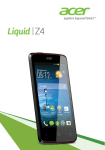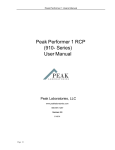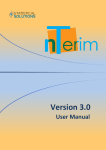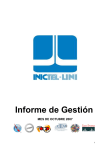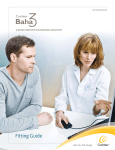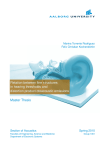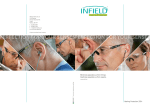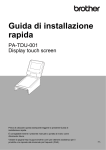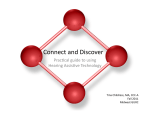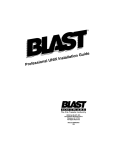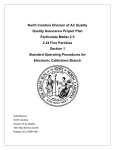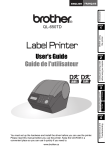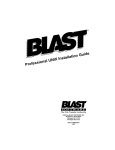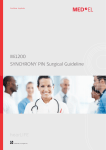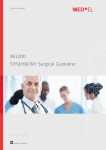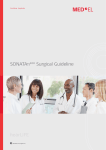Download UNC Adult Cochlear Implant Program.Cochlear Implant Journal
Transcript
UNC ADULT COCHLEAR IMPLANT PROGRAM COCHLEAR IMPLANT JOURNAL -0- TABLE OF CONTENTS CONTACT & CLINIC INFORMATION Welcome Letter Adult Cochlear Implant Team Reference Clinic Contact Information Parking Information Driving Directions Page 3 Page 4 Page 5 Page 6 Page 7 GETTING STARTED Evaluation Process Audiology Evaluation Checklist The Audiogram Page 10 Page 11 Page 12 ALL ABOUT SURGERY Pre-Surgery Information Day of Surgery Risks with Surgery Page 13 Page 15 Page 16 AFTER SURGERY Post-Surgery Information Warnings with a Cochlear Implant Personal Record of Cochlear Implant Information What to Expect at Initial Activation Initial Activation Checklist External Equipment Reference Initial Activation Routine Follow-up Appointments Two Week Appointment One Month Appointment -1- Page 17 Page 19 Page 20 Page 21 Page 23 Page 24 Page 25 Page 26 Page 27 Page 28 Three Month Appointment Page 29 Page 30 Page 31 Page 32 Page 33 Six Month Appointment One Year Appointment Two Year Appointment Three Year Appointment FUTURE REFERENCE What to do if your Equipment Breaks Bilateral Cochlear Implantation Tips for Traveling with a Cochlear Implant Cochlear Implant Companies Device Warranty Information Page 34 Page 36 Page 37 Page 39 Page 40 MENINGITIS VACCINATION Meningitis Vaccination Information Page 41 AURAL REHABILITATION Aural Rehabilitation Page 42 NOTES Notes Page 44 -2- WELCOME TO UNC Welcome to the adult cochlear (kō-klē-ər) implant program at UNC! We made this journal to help you through the steps of getting a cochlear implant. Many people with hearing loss have lived in quiet for a long time. People with a cochlear implant may hear sounds they have not heard in years. We know getting a cochlear implant is a big choice. Our goal is to help you make this choice and provide as much information as possible. The UNC cochlear implant program started more than thirty years ago. We are one of the biggest cochlear implant programs in the United States. Many people come to us from other states. We do about one hundred adult cochlear implant surgeries every year. We work with all three cochlear implant companies. These companies are Advanced Bionics, Cochlear and Med-El. There are steps to getting and doing well with a cochlear implant. The steps involve a team approach. This team includes you, your family, audiologists, speech language pathologists, nurses and doctors. The goal of this team is to help you do your best with a cochlear implant. Getting a cochlear implant is a journey to hearing better. We will work as a team to help make this journey as smooth as possible. Patients often ask how much better they will hear with a cochlear implant. This is a good question. Results can range from hearing sound (simple detection) to understanding speech in a noisy background. Results depend on a number of things. Some of these are a person’s hearing history, history of hearing aid use, and access to spoken language. For all patients, success with a cochlear implant requires wearing the device, practice, and returning for follow up visits. Thank you for choosing UNC to help you through this journey to better hearing. We look forward to working with you in the future. Let’s begin! -3- ADULT COCHLEAR IMPLANT TEAM DOCTORS Harold C. Pillsbury III, MD, FACS Professor & Chair, Department of Otolaryngology/Head and Neck Surgery Craig A. Buchman, MD, FACS Professor & Chief, Department of Otolaryngology/Head and Neck Surgery Oliver F. Adunka, MD Associate Professor, Department of Otolaryngology/Head and Neck Surgery NURSES Kristen Jewell, RN Clinical Nurse, Dr. Buchman & Dr. Adunka CLINICAL AUDIOLOGISTS Marcia Clark Adunka, AuD, CCC-A Director of Audiology Clinical Audiologist English R. King, AuD, CCC-A Clinical Coordinator of Adult Cochlear Implant Program Clinical Audiologist Ellen J. Pearce, AuD, CCC-A Clinical Audiologist RESEARCH AUDIOLOGIST Margaret T. Dillon, AuD, CCC-A Assistant Professor, Department of Otolaryngology/Head and Neck Surgery -4- CLINIC INFORMATION UNC HOSPITALS HEARING & VOICE CENTER AT CAROLINA CROSSING 2226 Nelson Highway Suite 102 Chapel Hill, NC 27517 Audiology Appointments: (919) 490-3716 Audiology Fax: (919) 490-5818 UNC DEPARTMENT OF OTOLARYNGOLOGY/HEAD AND NECK SURGERY Two Clinic Locations: NC NEUROSCIENCES HOSPITAL Ground Floor 101 Manning Drive Chapel Hill, NC 27514 CAROLINA CROSSING 2226 Nelson Highway Suite 101 Chapel Hill, NC 27517 ENT Appointments: (919) 966-6483 (for both locations) / (919) 490-3280 (Carolina Crossing) ENT Fax: (919) 843-9361 (Neurosciences) / (919) 490-5818 (Carolina Crossing) -5- PARKING AT UNC HOSPITALS MAIN CAMPUS Patients and visitors may park in the Dogwood Parking Decks or the Ambulatory Care Center parking lot at a cost of $1.50 an hour or part of an hour, to a maximum of $8 to park your vehicle for a full day. Coupons are available to Patients and Visitors in the Hospitals Parking Office for $8 each. These coupons will allow Patients or Visitors to enter and leave the deck multiple times during the day without acquiring extra charges. The Hospitals Parking Office is located in the building in front of N.C. Children’s Hospital. Valet Parking is available to all patients and visitors to any of the Hospitals and the Clinical Cancer Center. Valet is located in the building in front of the N.C. Hospitals. The cost for valet parking is $10. Valet coupons can be purchased from the Valet Cashier and come in books of five and cost $45. Payment for the Dogwood Deck or Valet can be made by cash, credit or debit card. Visitors and Patients may contact the Hospitals Parking Office for long term parking options at 919-966-1031. Handicapped Parking is available for up to four hours in any of the Handicapped Parking spaces located directly in front of the Memorial Hospital entrance. Additional handicapped spaces are located in the Dogwood Parking Deck. Handicappedaccessible shuttles service these spaces. If you need assistance from the parking deck, please contact the attendant via the call box phones. http://www.unchealthcare.org/site/transportation/Patient%20and%20Visitor%20Pa rking AT SATELLITE CLINIC Patients and visitors may park in lot outside of clinic. There is no cost to park at this location – UNC Hospitals Hearing & Voice Center at Carolina Crossing. -6- DIRECTIONS UNC HOSPITALS HEARING & VOICE CENTER AT CAROLINA CROSSING PHONE: (919) 490-3716 From I-40 West, take exit 273A You will merge onto 54 West (Will cross over I-40) Get in right lane. Stay straight through first light (Farrington Road) Stay in right lane (lane will end making you turn right) Turn right onto Nelson Highway (Hwy 54 Access/Service Road) Clinic will be on the LEFT (3-story light red brick building) From I-40 East, take exit 273 Turn right onto 54 West Get in right lane. Stay straight through first light (Farrington Road) Stay in right lane (lane will end making you turn right) Turn right onto Nelson Highway (Hwy 54 Access/Service Road) Clinic will be on the LEFT (3-story light red brick building) -7- DIRECTIONS UNC HOSPITALS DIRECTIONS FROM THE SOUTH: Take US 15-501 North to Chapel Hill. US 15-501 turns into South Columbia Street. Turn right on Manning Drive. Parking for the Hospital is in the Dogwood Deck garage. The Dogwood deck garage is 3/10 of a mile on the right. DIRECTIONS FROM THE EAST: Take I-40 West to exit #273A. Take NC 54 West to Chapel Hill. Take US 15-51 South to Manning Drive. Turn right on Manning Drive. Parking for the Hospitals is in the Dogwood Deck garage. The Dogwood Deck is 9/10 of a mile from US 15-501 on the left. DIRECTIONS FROM THE NORTH: Take NC 86 South. NC 86 turns into Martin Luther King Jr. Boulevard. Turn right onto Cameron Avenue (2nd light after Franklin Street). Turn left right away onto Pittsboro Street. Go left when the road splits. Go across South Columbia Street to be on Manning Drive. Parking for the Hospitals is in the Dogwood Deck garage. The Dogwood deck garage is 3/10 of a mile on the right. DIRECTIONS FROM THE WEST: Take NC 54 East to Chapel Hill. Exit at Columbia Street/US 15-501 Turn left onto South Columbia Street. Turn right on Manning Drive. Parking for the Hospitals is in the Dogwood Deck garage. The Dogwood Deck garage is 9/10 of a mile from US 15-501. -8- DIRECTIONS AMBULATORY CARE CENTER (ACC) DIRECTIONS FROM THE SOUTH: Take US 15-501 North to Chapel Hill. US 15-501 turns into South Columbia Street. Turn right on Manning Drive. Turn right on West Drive. Turn right on Mason Farm Road. The ACC entrance is ¼ miles on the left. The parking lot is around the building. DIRECTIONS FROM THE EAST: Take I-40 West to exit #273A. Take NC 54 West to Chapel Hill. Take US 15-51 South to Manning Drive. Turn right on Manning Drive. Turn left on West Drive. Turn right on Mason Farm Road. The ACC entrance is ¼ miles on the left. The parking lot is around the building. DIRECTIONS FROM THE NORTH: Take NC 86 South. NC 86 turns into Martin Luther King Jr. Boulevard. Turn right onto Cameron Avenue (2nd light after Franklin Street). Turn left right away onto Pittsboro Street. Go left when the road splits. Go straight across South Columbia Street to be on Manning Drive. Turn right on West Drive. Turn right again on Mason Farm Road. The ACC entrance is ¼ mile on the left. The parking lot is around the building. DIRECTIONS FROM THE WEST: Take NC 54 East to Chapel Hill. Exit at Columbia Street/US 15-501. Turn left onto South Columbia Street. Turn right on Manning Drive. Turn right on West Drive. Turn right again on Mason Farm Road. The ACC entrance is ¼ miles on the left. The parking lot is around the building. -9- EVALUATION PROCESS THE GOAL OF A COCHLEAR IMPLANT EVALUATION: Decide if getting a cochlear implant is a good option for you Go over test results Make suggestions based on results Give information about cochlear implant technology Answer questions THE EVALUATION PROCESS: Hearing Test o Audiologist (hearing specialist) will go over your hearing history o Test your hearing with and without hearing aids o Test your speech understanding with and without hearing aids Medical Check o A doctor who specializes in ears will go over your medications and health history o A scan or x-ray will most likely be done to look at the inside of your ear o The doctor will talk about surgery, procedure, and risks WHO IS A COCHLEAR IMPLANT CANDIDATE? Moderate to profound sensorineural hearing loss (sensory-neural, when there is damage to the inner ear or to the nerve pathways from the inner ear to the brain) in both ears Little or no benefit with hearing aids Clear understanding of cochlear implantation and end results Commitment to process and follow-up appointments - 10 - COCHLEAR IMPLANT AUDIOLOGY EVALUATION CHECKLIST Case History Unaided Audiogram Unaided Speech Reception Threshold Unaided Word Recognition Score Aided Audiogram Aided Speech Reception Threshold Aided Speech Perception Testing Review of Test Results Cochlear Implantation Discussion o Devices ____________________ o Processor/Wearing Options ____________________ o Battery Options ____________________ o Color Options ____________________ o Warranty ____________________ Follow-Up Schedule Use of Hearing Aid in other Ear MRI Compatibility (differs between manufacturers) Meningitis Vaccination Recommendation Auditory Rehabilitation Therapy Options - 11 - THE AUDIOGRAM Audiogram Source: http://www.medel.com/us/audiogram/ An audiogram is a picture which shows the softest levels you can hear. The tones that you listen for during a hearing test range from low-pitch to high-pitch. The loudness of the sound is measured in decibels (dB). The pitch or frequency of the sound is referred to in Hertz (Hz). This picture shows how your hearing differs from normal hearing and the degree of hearing loss that you have in each ear. - 12 - PRE-SURGERY SCHEDULING An ENT surgery scheduler will set-up these visits for you: o Pre-op with ENT doctor o Surgery o Post-op with ENT doctor An audiology scheduler will set-up your “initial activation”. This is when you get the outside part and start to hear sound with the implant. o You will get a call after you get home from hospital. o This is normally scheduled two to three weeks after surgery. o You may wear your hearing aid in the opposite ear. Please make sure your phone number, email, and address are correct in hospital system. Hospital staff may need to contact you. PRE-OP VISIT Your pre-op visit will start in the ENT Clinic. The doctor will check your medical history. The doctor will talk about risks of surgery. Consent forms will need to be signed. Your questions will be answered. You will also be seen in PRE-CARE for further testing, if needed. o Blood work, Electro-cardiogram (EKG) and chest X-Ray (CXR), if needed o Results are looked at before surgery You may have visits with other doctors. This will be needed if you have a medical problem that may be complicated by being put to sleep for surgery. Imaging of temporal bone will be taken (if not already done). The temporal bone is the part of your head where your organ of hearing is located. Be ready to be at UNC Hospitals for several hours. - 13 - PRE-SURGERY INFORMATION PRE-CARE will call the last day before your surgery. o If your surgery is on a Monday, they will normally call on the Friday before. PRE-CARE will tell you what time you should come for surgery. o The call will not be before 3:00 PM. Adult cochlear implant surgeries happen in the Ambulatory Care Center (ACC) or Main operating room on UNC’s hospital grounds. Tell us if you are sick or have a fever within three days of surgery. o You can reach the ENT clinic at (919) 966-6484. Do not take aspirin (or medications that have aspirin) within 2 weeks before your surgery day. Do not eat after midnight before your surgery. You may drink small amounts of clear liquids up to 2 hours before your arrival time. - 14 - DAY OF SURGERY Report to your surgery location. You will be taken to the pre-op area. Your family will be taken to a waiting area. The outpatient surgery will last about 2-3 hours. The doctor will talk to your family after the surgery. After you wake up, you will be taken to the recovery area. Your family will be able to come to your bedside. The nurse will be watching you as you continue to wake up. o Checking your vital signs, level of consciousness, bandage. Recovery times can vary. Plan to spend 23-hours in the hospital. This means an overnight stay. You will leave with a bandage/dressing over your ear. o The nurse will give you instructions on how to care for your ear at home. A prescription for an antibiotic and pain medication will be given to you. Please tell the doctor any medications you cannot take. - 15 - RISKS WITH SURGERY RISKS WITH COCHLEAR IMPLANT SURGERY: Loss of natural (or residual) hearing in implanted ear Greater chance for infection in the fluid around the brain and spinal cord (known as meningitis) Facial nerve stimulation / involuntary facial twitching Swelling (Inflammation)/Pushing or thrusting out (Extrusion) o Soreness, redness, breakdown of skin in area around device Failure of implanted device Greater chance for infection in the fluid around the brain and spinal cord (Meningitis) Please find full information regarding meningitis vaccination on last pages of CI journal RISKS WITH ANY EAR SURGERY: Numbness/tenderness around the ear Neck pain Injury to the facial nerve Taste change (dry mouth or a metal taste in mouth) Leak of inner ear fluid (Perilymph) or fluid that surrounds the brain (Cerebrospinal) Dizziness / Vertigo Ringing in the ears (Tinnitus) Local complications such as blood, fluid or infection at or near surgery site Rashes (skin reactions) GENERAL RISKS: Post-surgery pain, scarring, bleeding and infection Risks associated with being put to sleep (problems with the heart, lungs, kidneys, liver and brain due to general anesthesia) - 16 - POST-SURGERY Please call the doctor’s nurse or the triage nurse if you have questions once you are home. If you have questions after clinic hours (8:30-4:30 M-F), please call 919966-4131. o This is the UNC Hospital main telephone number. o Ask to speak to the ENT doctor-on-call. You may have a sore throat for a few days. You may have dry mouth or a metal taste for a few weeks after surgery. But, this may last longer. Start with clear liquids at first. Then try to eat solid food. Try not to eat hard or crunchy foods the first week. A stiff neck or pain in your neck can last for a few weeks after the surgery. Lack of feeling/numbness or stiffness around your ear is normal. This can last for a few months. Your ear may stick out for a few days from swelling. It should go back to normal as your ear heals. Call right away if clear liquid starts dripping from your nose. Dizziness can be normal for a little while after surgery. Do not take off the bandage (unless told by the doctor). Do not get the bandage wet. The bandage will catch any drainage and help stop buildup of fluid. Pinkish drainage is normal. Call right away if bright red drainage is found. The doctor will take off the bandage at your first post-op visit to look at the site. - 17 - POST-OP VISIT You will come back about one week after surgery to have your bandage taken off by the doctor. The doctor will make sure site is healing well and there is no sign of infection. The audiologist may check the inside piece to make sure it is working. o Also done in the operating room at time of surgery. o This only takes a few minutes. - 18 - WARNINGS WITH A COCHLEAR IMPLANT Be careful when playing sports and in certain activities (contact sports, bicycling, and rollerblading) without a helmet. Try not to hit head during activity (football, soccer, etc.). Wear a helmet for sports like riding a bicycle. If the inside piece is not working, then you may need another surgery. This is called a “revision surgery”. The US Food and Drug Administration (FDA) does not allow or limits certain imaging (MRI = magnetic resonance imaging) with a cochlear implant. This differs between manufacturers. Please check with your doctor or audiologist. The use of high-frequency electric current to cut tissue during surgery (Electrosurgery) and electroshock therapy can permanently hurt the device. Electrically induced heat (Diathermy) or spinal cord stimulation (neurostimulation) cannot be used over the implant. This can hurt the cochlear tissue and the inside piece. A treatment for some types of cancer (Ionizing radiation) will hurt the inside piece. If you have a medical problem or question, please contact your cochlear implant doctor. - 19 - COCHLEAR IMPLANT INFORMATION Date Implanted: ________________________________________ CI Company: ________________________________________ Ear Implanted: ________________________________________ Processor Type: ________________________________________ Speech Processor Serial Number(s): ________________________________________ Warranty ends: ________________________________________ Doctor: ________________________________________ Contact Number: ________________________________________ Nurse: ________________________________________ Contact Number: ________________________________________ Audiologist(s): ________________________________________ Contact Number: ________________________________________ Contact E-mail: ________________________________________ Fax Number: ________________________________________ - 20 - WHAT TO EXPECT AT “INITIAL ACTIVATION” You can keep using your hearing aid in the other ear until you come to your “initial activation” visit. This is when you get the outside part of your implant and start to hear sound. At this visit, we will ask that you not wear your hearing aid in the other ear. After several months with your new implant, you may go back to wearing your old hearing aid also. For some patients, we may talk about getting a second cochlear implant. About two to four weeks after surgery, you will be fit with the outside part of the cochlear implant. This time allows your ear to heal. The main outside piece is called the speech processor. It has to be “mapped” or programmed for you to hear sound through the cochlear implant. During the first six months of hearing with your implant, reprogramming or remapping is done about five times. As your hearing and understanding with the cochlear implant gets better, less reprogramming visits are needed. To begin, the speech processor is put behind your ear. The outside magnet (coil) is put on your head. The outside magnet and the inside magnet connect to each other. The coil is connected to the speech processor by a transmitting cable. Next, the programming or “mapping” of the speech processor begins. The speech processor is connected to the audiologist’s computer. Individual electrodes of the implant are stimulated. You will hear a series of “beeps”. You will hear different pitches or tones. The audiologist will measure your response to these sounds. We are trying to figure out the levels that are loud but comfortable. We may also measure sounds that are very soft. After measuring these sounds, the speech processor microphone is turned on. This will let you hear sounds that are around you, including speech. The volume will be turned up slowly. Hearing speech through your cochlear implant may sound unnatural at first. The sound you hear on the first day of listening is different for every patient. - 21 - For some, speech may sound like “beeps”. For others, speech may sound like a voice. Typically if it sounds like a voice, it is not a normal voice. Patients often describe speech as sounding “mechanical”, “cartoonish”, “Mickey Mouse”, “Donald Duck”. The quality of sound will get better with time and practice. Finally, your “map” is saved to the speech processor. We will counsel on how to use, troubleshoot, care for and maintain your outside equipment. With each day, with each week, you will hear and make out more sounds as you listen. Learning to listen again and understand what you are hearing takes time and practice. Be patient. Your family and friends should speak to you normally. They do not need to raise their voices. Having others read books, magazines, and newspapers aloud are good ways to practice listening. Listening to books on tape, while you follow along in reading is a good way to practice on your own. Please ask your audiologist for other ways or ideas that you can learn and practice at home. - 22 - COCHLEAR IMPLANT INITIAL ACTIVATION ORIENTATION CHECKLIST EQUIPMENT: Identification of external parts o Processor/Control Unit, cable, headpiece/coil, battery pack Device operation & troubleshooting Equipment care & maintenance Batteries Accessories Use of remote control (if applicable) Ordering parts & batteries o Manufacturer versus online (www.microbattery.com) DOCUMENTS: Manufacturer registration User manual ID card o Warnings & Precautions; Caution of MRI (differs between manufacturers) Manufacturer patient information/insurance forms RECOMMENDATIONS: Read user manual before next visit Wear device all waking hours Check magnet site. If redness or swelling occurs, call your ENT surgeon Try to work through all programs - 23 - EXTERNAL EQUIPMENT Please refer to your Company’s User Manual for instructions on how to use your remote (if applicable) as well as care and maintenance of your external unit. Sound Processor AB Naida CI Q70 Power Source Universal Headpiece Cable MED-EL OPUS 2 COCHLEAR CP910 (Nucleus 6) Coil & Magnet Sound Processor Cable Battery Module - 24 - INITIAL ACTIVATION DATE: ____________________ This visit is 2-3 weeks after surgery. It will be about two hours long. Today you will hear through the cochlear implant. At this visit, we will ask that you not wear your hearing aid in the other ear You will be fit with your outside equipment (speech processor, battery pack, transmitting cable and coil / headpiece). A program or “MAP” is made by measuring sounds that you hear through the cochlear implant. This is done while connected to audiologist’s computer. You will hear different pitches or tones as each electrode is stimulated. We will increase the volume of each tone until it is a loud but comfortable level. You may also listen for sounds that are very soft. We will turn on the microphone. We will ask you to tell us what you are hearing. You may hear anything from “bells” to speech. This is normal. We will talk about many things today. We will teach you how to use, troubleshoot, care for and maintain your equipment. We know that you may not remember everything. We will complete product registration and talk about warranty information. Please read your user manual and bring any questions you have to your next appointment. You will return for your next follow-up appointment in 2-3 weeks. NEW PROGRAMS: PROGRAM 1: _______________ PROGRAM 2: _______________ PROGRAM 3: _______________ PROGRAM 4: _______________ - 25 - AUDIOLOGY FOLLOW-UP VISITS You will learn and adjust with the cochlear implant more quickly in the beginning. For this reason, a lot of mapping changes are needed in the first year. We will see you for multiple follow-up testing and mapping sessions in the first year. o 2-weeks after initial activation o 1-month after initial activation o 3-months after initial activation o 6-months after initial activation o 12-months after initial activation After one year, patients are normally seen once a year. These yearly visits are important. We want to make sure you continue to do well with your cochlear implant. - 26 - TWO WEEK APPOINTMENT DATE: ____________________ You have now heard many new sounds. You may have many questions. It may help to write all of these down. That way we can make sure to answer them during your appointment. We will start in the test booth. You will listen for some soft sounds and speech. We will then check the inside piece. We will also reprogram the speech processor. Changes are made to the programs at every appointment. This helps you hear more sound as you learn to listen with the cochlear implant. NEW PROGRAMS: PROGRAM 1: _______________ PROGRAM 2: _______________ PROGRAM 3: _______________ PROGRAM 4: _______________ - 27 - ONE MONTH APPOINTMENT DATE: ____________________ We start this appointment in the test booth. We will test you with your cochlear implant. You will listen to soft sounds and speech. These scores will be compared to your past scores. Testing gets harder as you progress. We will then check the inside piece. We will reprogram the speech processor. NEW PROGRAMS: PROGRAM 1: _______________ PROGRAM 2: _______________ PROGRAM 3: _______________ PROGRAM 4: _______________ - 28 - THREE MONTH APPOINTMENT DATE: ____________________ We will begin this appointment in the test booth. We will test you with your cochlear implant. You will listen to soft sounds and speech. These scores will be compared to your old scores. We will then check the inside piece. We will reprogram the speech processor. NEW PROGRAMS: PROGRAM 1: _______________ PROGRAM 2: _______________ PROGRAM 3: _______________ PROGRAM 4: _______________ - 29 - SIX MONTH APPOINTMENT DATE: ____________________ We will begin this appointment in the test booth. We will test you with your cochlear implant. You will listen to soft sounds and speech. These scores will be compared to your old scores. We will then check the inside piece. We will reprogram the speech processor. NEW PROGRAMS: PROGRAM 1: _______________ PROGRAM 2: _______________ PROGRAM 3: _______________ PROGRAM 4: _______________ - 30 - ONE YEAR APPOINTMENT DATE: ____________________ Congratulations! You have now had your cochlear implant for one year. From now on, you will only need to schedule follow-up visits for once a year. But you can make an appointment before that if needed. We will begin this appointment in the test booth. We will test you with your cochlear implant. You will listen to soft sounds and speech. These scores will be compared to your old scores. We will then check the inside piece. We may reprogram the speech processor. NEW PROGRAMS: PROGRAM 1: _______________ PROGRAM 2: _______________ PROGRAM 3: _______________ PROGRAM 4: _______________ - 31 - TWO YEAR APPOINTMENT DATE: ____________________ We will begin this appointment in the test booth. We will test you with your cochlear implant. You will listen to soft sounds and speech. These scores will be compared to your old scores. We will then check the inside piece. We may reprogram the speech processor. NEW PROGRAMS: PROGRAM 1: _______________ PROGRAM 2: _______________ PROGRAM 3: _______________ PROGRAM 4: _______________ - 32 - THREE YEAR APPOINTMENT DATE: ____________________ Today’s appointment should be scheduled just before the end of your warranty (if applicable). Your warranty may be three years or five years. This depends on your cochlear implant company. We will look at all of your equipment to make sure it is working properly. The equipment that is not working it will be replaced through the company. We will begin this appointment in the test booth. We will test you with your cochlear implant. You will listen to soft sounds and speech. These scores will be compared to your old scores. We will then check the inside piece. We may reprogram the speech processor. NEW PROGRAMS: PROGRAM 1: _______________ PROGRAM 2: _______________ PROGRAM 3: _______________ PROGRAM 4: _______________ - 33 - WHAT TO DO IF YOUR EQUIPMENT BREAKS At some point your outside equipment may stop working. When this happens, your equipment may need to be repaired or replaced. Please keep in mind that you should have back up equipment that you can use. You received this back up equipment at your initial activation. It should be in your kit. So hopefully you will never have to be “off the air”. Please take the following steps: 1) Pull out your user manual. Look over the troubleshooting section. 2) If you cannot fix the problem yourself, call or email your cochlear implant company. They can help you troubleshoot the problem and workout what parts need to be replaced. All companies have audiologists who can respond quickly. **We ask that you call your company first before calling the clinic. This will likely save you time and help in getting you back to hearing more quickly. ADVANCED BIONICS 1-877-829-0026 COCHLEAR (HEAR ALWAYS) 1-800-483-3123 MED-EL 1-888-633-3524 3) Call the clinic at (919) 490-3716 if you are still having a problem. Ask for a cochlear implant audiologist. If we are not available, please leave a message. Tell us what is happening and which parts (and serial numbers) you are having problems with. We will contact you as soon as possible. IF YOU ARE IN WARRANTY The company can send replacement parts to your home. If you are in warranty, there should be no cost to repair/replace external parts (does not apply to accessories). - 34 - These parts are normally shipped via Fed-Ex. DO NOT throw the bad parts away. The company will want the bad parts back. Your replacement equipment will come with a pre-paid, pre-addressed Fed-Ex label. Use this label to ship the broken parts back to the company. IF YOU ARE OUT OF WARRANTY If you are out of warranty, there will most likely be a cost to you to replace or repair parts. In some cases, insurance plans may cover some of this cost. Requests normally have to be approved through insurance first. This means the process of repairing or replacing equipment may take longer. If you have Medicare: Contact the company to figure out what parts need to be replaced. You can order these parts from the company. The company should contact you when insurance approval has been received. They will let you know if and how much money you owe. Medicare normally covers 80% of the cost of a repair or replacement. Parts can normally be shipped to your home. Again, you will need to ship the broken equipment back to the company. If you have Private Insurance: The company may be able to ask for approval from your insurance provider, but you may have to pay up front. If your insurance approves, you may get repaid from the insurance provider. All three companies offer extended warranty. The price of these “service contracts” varies. It is in your best interest to buy an extended warranty when the original warranty ends. Please contact your cochlear implant company for more information. - 35 - BILATERAL COCHLEAR IMPLANTATION Views on having a cochlear implant in both ears (bilateral cochlear implantation) have changed a lot in recent years. It is more common to implant both ears. If a patient has limited benefit from a hearing aid in the other ear, we may talk about the option of a second cochlear implant. If a patient still has usable hearing in the other ear, we may recommend a hearing aid in this ear along with the cochlear implant. This decision is unique to each patient. Research shows that two ears are better than one. In order for a patient to do his/her best, bilateral cochlear implantation may be recommended. There are several benefits of having two cochlear implants: Better speech understanding in noise Being able to know where sounds come from (localization) Never being without sound. If the internal or external parts from one cochlear implant side need repair or replacement, patient can still hear with the other side. Most insurance providers support bilateral cochlear implantation. Determining candidacy for bilateral cochlear implantation would be made by the CI team – CI audiologist, surgeon, and patient/family. Certain criteria must be met in order to be considered a candidate for a second side implant: Successful and consistent use of the first device Active participation in follow-up care No physical contraindications for placement of the implant (any medical reason for not getting implant, i.e., CT scan results) Medically cleared for surgery Realistic expectations and commitment to follow-up appointments - 36 - TIPS FOR TRAVELING Take extra parts (like a back-up speech processor, battery pack, coil, and cables) with you in case of emergency. Take plenty of batteries (disposable or rechargeable). If you use rechargeable, do not forget your battery charger (and adapter if needed). Remember to take your drying jar or Dry & Store box with you so you can put your processor in it overnight. This is important if you will be somewhere with high humidity. Will anything happen to my cochlear implant when I walk through airport security? Not normally. You should leave your speech processor on so you can hear what is going on around you. If your processor is set on the telecoil “T” setting, you may hear some buzzing. This is normal. If the metal detector alarm goes off, what should I do? Metal detectors and scanners will not hurt the inside piece or outside speech processor. If you pass through the security metal detector, your cochlear implant may set the alarm off. If the alarm goes off, security may use a handheld wand to screen you. The wand will not harm your cochlear implant, but it will beep when it passes over your implant. Show your patient ID card and explain that you have a hearing implant. Tell them that the speech processor is a hearing device that you must wear in order to hear through the implant. What should I do with my back-up speech processor when I fly? Turn your spare speech processor OFF and keep it inside a carry-on bag. Place the bag onto the conveyer belt at airport security. Never place your processor right onto a conveyer belt. Static electricity may build up and harm your MAP or program. The xray machine should not affect your MAP if the processor is turned off. - 37 - Note: A low-level x-ray is used to screen carry-on luggage. The x-ray will not harm your processor or the MAP. Never put your spare processor into checked baggage as this could expose it to damaging x-rays. Will my implant send signals that can interfere with the plane's navigational instruments? Your implant cannot get in the way of the plane’s systems. Your implant sends out radio frequency (RF) signals. They are very short range (less than five feet from the outside coil). Your remote assistant or Fine Tuner (if applicable) does send out high frequency radio waves and should be turned off during take-off and landing. If your remote does not have an “off” switch, do not use it. Like other electronic devices, should I turn off my speech processor during take-off and landing? No. Cochlear implant patients DO NOT have to turn off their speech processors when instructions are given to turn off cell phones, music players or anything with an on/off switch. The FAA views a cochlear implant in the Hearing Aid category. If you have a remote control for your speech processor, this should be turned off or not used during this time. How can I listen to the in-flight music or watch a movie? You can plug your speech processor into the plane’s audio system. You would need to use your audio cable accessory. (See your user manual on how to connect the Audio Adaptor Cable to your speech processor.). Further questions regarding the TSA’s guidelines for airport screening and how it relates to your hearing loss and cochlear implant, may be found at: http://www.tsa.gov/traveler-information/travelers-disabilities-and-medicalconditions Resource: http://www.cochlear.com/wps/wcm/connect/us/recipients/recipient-support/nucleus/nucleus-5/livingwith-your-device/traveling-tips - 38 - COCHLEAR IMPLANT COMPANIES Advanced Bionics Corporation 28515 Westinghouse Place Valencia, CA 91355 http://www.advancedbionics.com/us/ 1.877.829.0026 Cochlear Corporation 13059 E. Peakview Avenue Centennial, CO 80111 www.cochlearamericas.com 1.800.483.3123 MED-EL Corporation 2511 Old Cornwallis Road, Suit 100 Durham, NC 27713 http://www.medel.com/us/ 1.888.633.3524 - 39 - DEVICE WARRANTY INFORMATION “In warranty” means there is no cost to repair or replace broken parts. Advanced Bionics offers a 3-year warranty for the sound processor, headpiece (magnet and cable), and charger. The T-mic is covered for 1 year. The rechargeable batteries are covered for 90 days. Cochlear Corporation offers a 5-year warranty for the sound processor, transmitting cable, coil, and Remote Assistant. The battery holder (for disposable batteries) and the rechargeable batteries are covered for 1 year. MED-EL offers a 5-year warranty for the external sound processor, transmitting cable, coil, battery packs (all types), rechargeable batteries, and Fine Tuner. *** Parts are replaced due to “normal wear and tear” only. The warranty for the outside parts starts the day you get your equipment. A one-time replacement for loss and damage (beyond repair) is offered during this warranty period. You can buy coverage through the company after the three year warranty ends. The warranty for the inside part starts the day of your surgery. Cochlear implants are man-made medical electronic devices. The internal devices are made to last a long time, but they may not last a lifetime. All three CI companies offer a 10-year warranty for the inside piece. - 40 - MENINGITIS VACCINATION Dear Cochlear Implant Candidate: We are writing to tell you about getting a vaccination (shot) for an infection called meningitis. Shots can help protect you from pneumococcal infections. This infection may become meningitis. It is an infection in the fluid around the brain and spinal cord. Meningitis is serious and life threatening. The Food and Drug Administration, Centers for Disease Control and health departments looked at meningitis rates with children with cochlear implants. They found children with cochlear implants at a higher risk for getting meningitis than those without. We believe this is important for adults as well. That is why it is suggested that adults with cochlear implants get the recommended shots to help reduce their chance of getting meningitis. There are two main types of meningitis: viral and bacterial. Bacterial is the more serious type. Two types of bacterial meningitis have been found in people with cochlear implants. These types are Streptococcus pneumonia (“Pneumococcus”) and Haemophilus influenzae type B. The symptoms, treatment and results depend on the cause of the infection. The Center for Disease Control recently changed the guide for meningitis shots for adults with cochlear implants. The new guide is for users to get both the 23-valent pneumococcal polysaccharide vaccine (Pneumovax 23, PPSV23) and the 13-valent pneumococcal conjugate vaccine (Prevnar 13, PCV 13). Please talk to your doctor about the shot and your case. Keeping this infection from happening is important. Please get this shot before your surgery. You can get this shot from your general doctor or your local county health department. For more information, please visit the Center for Disease Control’s website at: http://www.cdc.gov/mmwr/preview/mmwrhtml/mm6140a4.htm?s_cid=mm6140a4_w - 41 - AURAL REHABILITATION You got a cochlear implant and had it turned on. Now you need to learn how to listen and understand all of the new sounds coming from your implant. Research has shown that adults make faster progress in their understanding of speech and sounds using a treatment called Aural Rehabilitation (Aural Rehab). What is Aural Rehab (also called Auditory Therapy)? In Aural Rehab, you will learn how to listen and understand the new sounds that come from your cochlear implant. Aural Rehab can improve your skills when talking with others. Improving these skills may help you feel more secure with your implant. Aural Rehab includes exercises that help you: Understand the difference between sounds and whole words Understand new sounds that have not been heard before Read along and follow someone else’s speech while they read aloud Notice when you or someone you are talking to does not understand what is said. Learn when to change your setting to improve your understanding. Learn how to set up the phone to work with your implant Enjoy music Learn how your implant affects the people around you, and help your family and friends learn about your implant Make your speech more clear. Learn and practice skills that will make you more comfortable when talking UNC Health Care has a great staff of speech language pathologist (SLPs) that offer Aural Rehab to our patients with cochlear implants. The first step is to meet with the SLP for an evaluation. At this appointment, the SLP will check what skills you have and what skills you need help with by testing: How you make speech sounds - 42 - How you understand speech Your memory Your reading and writing skills Your listening skills How well you can understand someone talking without being able to see their lips We encourage all patients to make an Aural Rehab evaluation appointment with one of our speech language pathologists to learn what this therapy can offer you. You can make an appointment at UNC Hospitals Hearing & Voice Center by calling (919) 490-3716. There are also some free resources available online which you can listen and practice with at home. Some of these programs include: Angel SoundTM is a free, upgraded version of “Sound and WAY Beyond”, an auditory rehabilitation program based on CAST technology and distributed by Cochlear Americas. Available at: http://angelsound.tigerspeech.com/ The Listening Room sponsored by Advanced Bionics has free activities and resources to support the development of speech, language and listening. Available at: http://hearingjourney.com/Listening_Room/preview.cfm?langid=1 SoundScape sponsored by MED-EL has interactive listening activities for various age groups. Available at: http://www.medel.com/us/show4/index/id/255/titel/SoundScape - 43 - NOTES DATE: ____________________ __________________________________________________________________ __________________________________________________________________ __________________________________________________________________ __________________________________________________________________ __________________________________________________________________ __________________________________________________________________ __________________________________________________________________ __________________________________________________________________ DATE: ____________________ __________________________________________________________________ __________________________________________________________________ __________________________________________________________________ __________________________________________________________________ __________________________________________________________________ __________________________________________________________________ __________________________________________________________________ __________________________________________________________________ DATE: ____________________ __________________________________________________________________ __________________________________________________________________ __________________________________________________________________ __________________________________________________________________ __________________________________________________________________ __________________________________________________________________ __________________________________________________________________ __________________________________________________________________ - 44 - NOTES DATE: ____________________ __________________________________________________________________ __________________________________________________________________ __________________________________________________________________ __________________________________________________________________ __________________________________________________________________ __________________________________________________________________ __________________________________________________________________ __________________________________________________________________ DATE: ____________________ __________________________________________________________________ __________________________________________________________________ __________________________________________________________________ __________________________________________________________________ __________________________________________________________________ __________________________________________________________________ __________________________________________________________________ __________________________________________________________________ DATE: ____________________ __________________________________________________________________ __________________________________________________________________ __________________________________________________________________ __________________________________________________________________ __________________________________________________________________ __________________________________________________________________ __________________________________________________________________ __________________________________________________________________ - 45 - NOTES DATE: ____________________ __________________________________________________________________ __________________________________________________________________ __________________________________________________________________ __________________________________________________________________ __________________________________________________________________ __________________________________________________________________ __________________________________________________________________ __________________________________________________________________ DATE: ____________________ __________________________________________________________________ __________________________________________________________________ __________________________________________________________________ __________________________________________________________________ __________________________________________________________________ __________________________________________________________________ __________________________________________________________________ __________________________________________________________________ DATE: ____________________ __________________________________________________________________ __________________________________________________________________ __________________________________________________________________ __________________________________________________________________ __________________________________________________________________ __________________________________________________________________ __________________________________________________________________ __________________________________________________________________ - 46 - NOTES DATE: ____________________ __________________________________________________________________ __________________________________________________________________ __________________________________________________________________ __________________________________________________________________ __________________________________________________________________ __________________________________________________________________ __________________________________________________________________ __________________________________________________________________ DATE: ____________________ __________________________________________________________________ __________________________________________________________________ __________________________________________________________________ __________________________________________________________________ __________________________________________________________________ __________________________________________________________________ __________________________________________________________________ __________________________________________________________________ DATE: ____________________ __________________________________________________________________ __________________________________________________________________ __________________________________________________________________ __________________________________________________________________ __________________________________________________________________ __________________________________________________________________ __________________________________________________________________ __________________________________________________________________ - 47 - Approved by UNCH Pt. Education Committee 10/1/2013 FK:5.1 HDF #3829 - 48 -

















































